While they might not be your typical houseplant, did you know that you can actually grow tomatoes indoors all winter long? Not only is it possible, but it’s the perfect way to have fresh tomatoes even as the snow flies outside your window!
Tomato plants are almost always thought of as an “outside” plant. The warm soil and sun-loving plant certainly grows best through the summer months. With the long daylight hours and warmth that the summer sun provides, enjoying the taste of fresh tomatoes is quite easy.
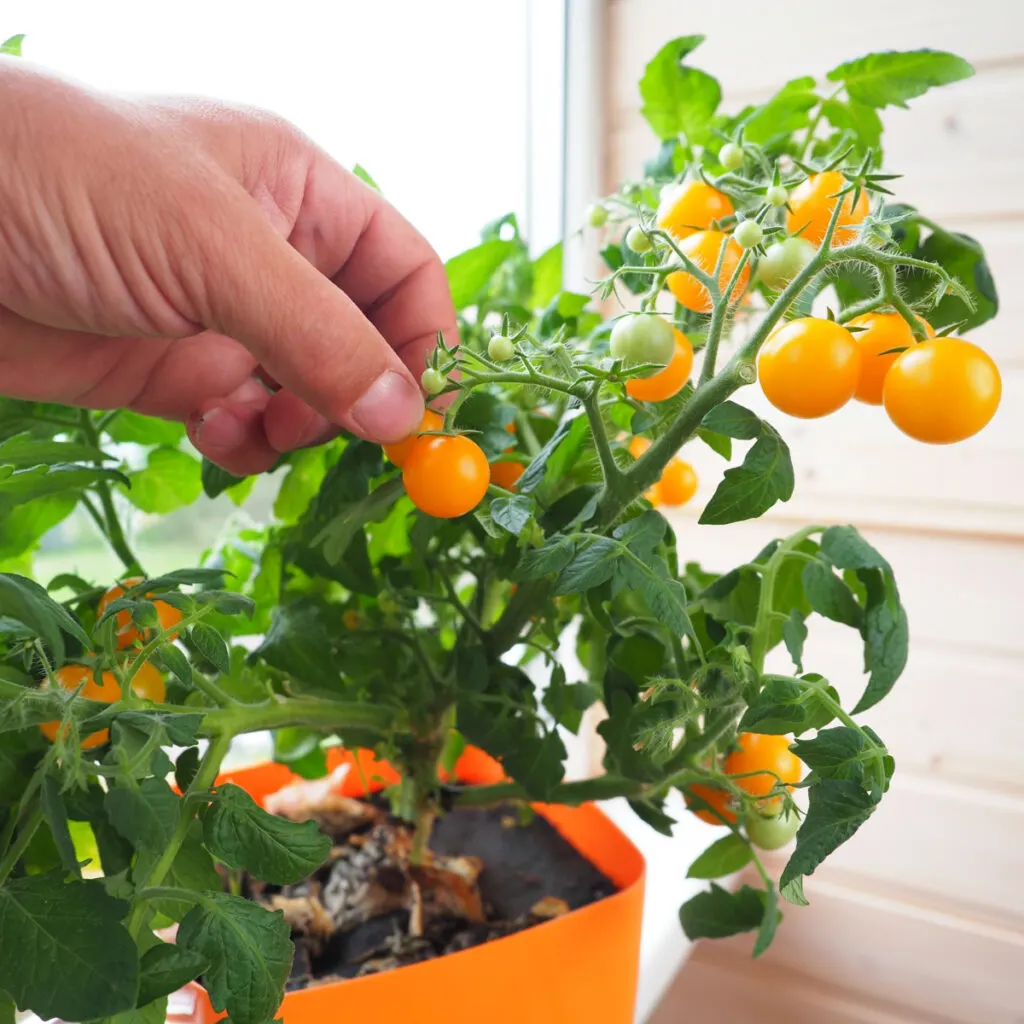
But once summer is over, the plants inevitably start to fade and the growing season fades away quickly. Unfortunately for many gardeners, that leaves the fall and winter months without access to fresh, homegrown tomatoes to enjoy. And those store bought versions just don’t cut it!
But here’s the good news – you don’t have to wait until next summer for ripe, tasty tomatoes! Not when you can grow a few small plants indoors. Best of all, the process is easy and doesn’t require expensive grow lights or equipment.
How To Grow Tomatoes Indoors In The Winter – The Simple Secrets To Success!
While the process of growing tomatoes indoors is fairly simple, there are a few things to keep in mind to ensure a successful harvest. For starters, you need to select the right type of tomato to grow.
Tomatoes come in two main types: determinate and indeterminate. Determinate tomatoes grow to a certain size and then produce fruit that is ready to be harvested all at about the same time. Indeterminate tomatoes, on the other hand, continue to grow and produce fruit all throughout the growing season.
For indoor growing, you have the best chance of success with determinate tomatoes. These varieties tend to stay more compact and don’t become unruly or overly large like indeterminate tomatoes can. They also usually require less soil, which can be critical when growing indoors.
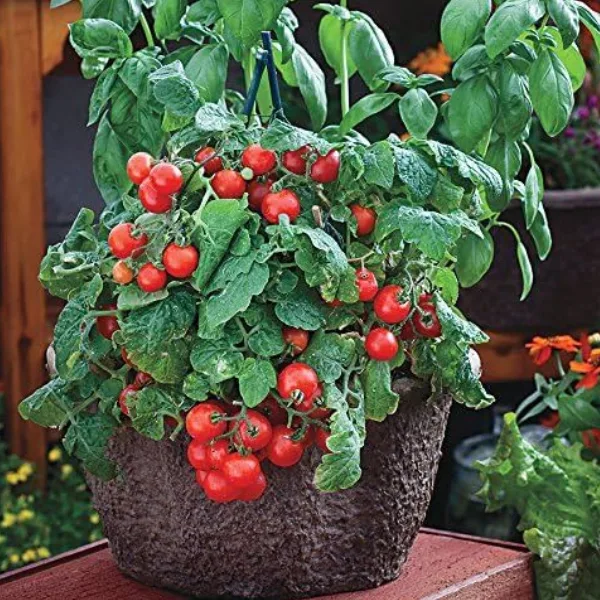
The Best Varieties Of Tomatoes To Grow Indoors In The Winter
When growing indoors, look for varieties that are specifically labeled for patio or container growing. It’s best to stick with smaller fruit-like paste or cherry tomatoes. Another great choice are dwarf varieties that are much more compact and easier to grow in limited space.
Some great choices to grow indoors in the winter are:
- Red Robin Cherry Tomato: A dwarf determinate tomato that grows between 8 to 12 inches tall and produces sweet 1-inch-sized fruit. Affiliate Seed Link: Red Robin Seeds
- Patio Choice Red Hybrid Cherry Tomato: A determinate tomato that produces high yields of fruit and grows between 24 to 30 inches tall. They work great grown in hanging baskets. Affiliate Seed Link: Patio Choice Cherry Tomato Seeds
- Tiny Tim Tomato: A small, 12-inch determinate tomato plant that produces cherry tomatoes in just 50-60 days. Affiliate Seed Link: Tiny Tim Tomato Seeds
- Early Girl Bush: A determinate tomato that produces 6-7 ounce slicing tomatoes on a low-growing, compact bush. Affiliate Seed Link: Early Girl Bush
While all of these might not produce a ton of fruit at once, you can grow multiple plants and use succession planting to ensure you have a continual supply of fresh fruit. Of course, having some fresh tomatoes is far better than having none!
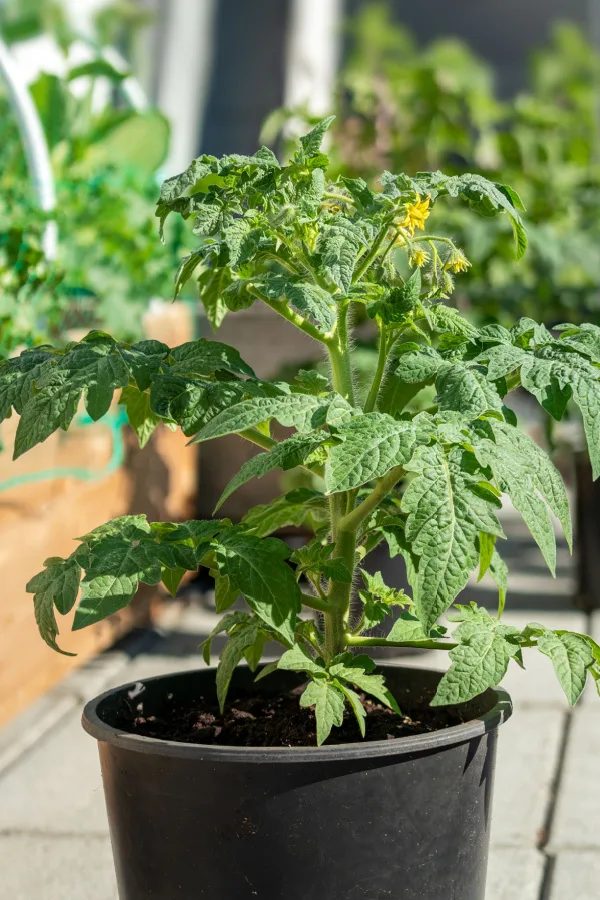
Starting Seeds Indoors – How To Grow Tomato Plants Indoors In The Winter
Growing indoors means that you will most likely be growing from seed. There are not usually too many nurseries or greenhouse that have ready-to-go transplants in late fall or winter. With that said, starting seeds indoors is actually quite easy, especially since you can plant seeds directly into the pots you will be growing in.
When growing tomatoes indoors, you want to choose a container that will be large enough to hold and support the mature tomato plant. The containers should also have plenty of drainage holes at the bottom as well.
If you are growing dwarf varieties that grow to less than a foot tall, you can get by with only having 6 to 8-inch pots. However, if you are growing larger, bush varieties, you will need to use a container that is at least a foot in diameter, if not more.
You should never have more than one tomato growing in a single pot. But when sowing seed to start, plant several seeds to ensure one germinates. You can then thin as they begin to sprout. For even more on seed starting, you can also check out our article: How To Start Tomato Seeds Indoors.
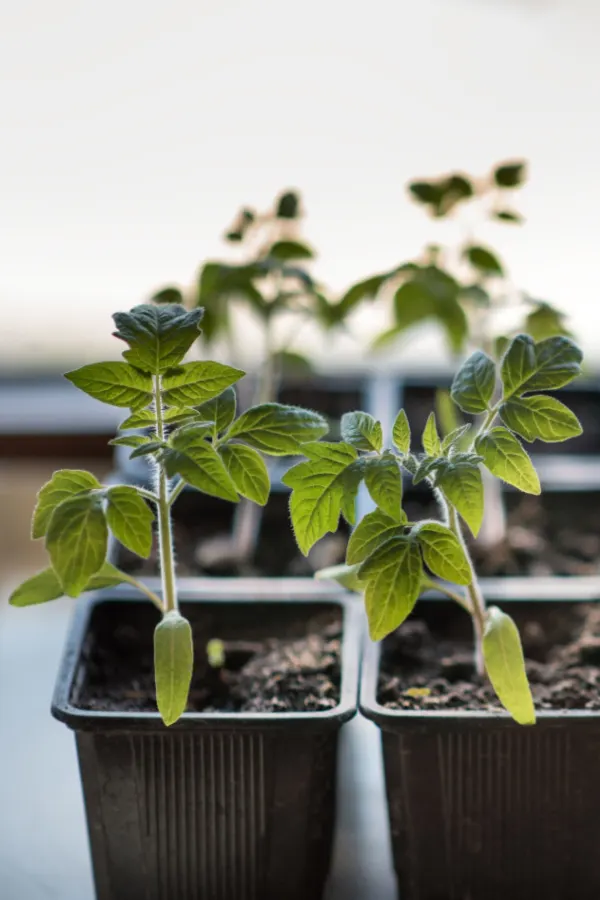
Caring For Your Plants – How To Grow Tomato Plants Indoors In The Winter
The biggest goal in having success with growing tomatoes indoors is to mimic the outside conditions as much as possible. This includes the growing space, soil, lighting conditions, watering, airflow, and help with pollination.
For starting the tomato seeds indoors, begin with using a light, fertile, all purpose potting soil. This soil will allow the seeds to both germinate easily and quickly mature. Adding compost and/or worm castings to the soil mixture prior to planting can really boost the nutrients for the plants, which can really help with winter growing.
Sunlight Versus Artificial Light – How To Grow Tomato Plants Indoors In The Winter
Tomatoes require at least 6 to 8 hours of direct sunlight each day. This can be hard to come by during the short days of winter for most locations – especially indoors. In fact, lighting is usually the biggest issue to overcome when winter growing.
If you have a large southern facing window, you can place your tomato plant directly in front of the window. Make sure to rotate the plant every couple of days so that all sides get equal amounts of sunlight.

However, it is likely in many areas that you may need the additional help of artificial light. But here is the good news – you don’t need to go purchase expensive grow lights! Ordinary LED shop lights provide more than enough light for tomatoes indoors.
All you need to do is keep the lights a couple of inches above the plant and move them up as the plant grows. This helps to prevent the tomato plant from being tall and leggy. If only using artificial light, keep lights on for 12 to 14 hours each day. If supplementing with window light, an additional 4 to 6 hours of light will do the trick.
Pollination
When you grow tomatoes indoors, there is no access to pollinators. Even though tomatoes are self-pollinating and don’t require insects, you can still give the plants a little help in order to ensure a successful harvest.
To help with pollination, you can use a couple of different methods to mimic conditions outside. One of the easiest is to add a small oscillating fan to the area. This helps to move the pollen around as well as prevent stagnant air around plants. A few hours a day is more than enough when the plant has blooms.
Another option is to gently shake the plant every day while the plant is in bloom. Last but not least, you can always hand-pollinate the blooms to transfer the pollen from one flower to another. A cue tip swabbed on the flowers works incredibly well for this.
Water & Fertilizer
The amount of water you give tomatoes growing indoors will depend on their size and growing stage, the temperature within your home, and how large their growing container is.
Water your tomato plants after the top inch or two of soil is dry. Using a tray under the containers will help to catch excess water and any soil that might leak out after watering. Avoid overwatering or allowing the tomato plants to sit in water since this can cause root rot and a whole host of other issues.
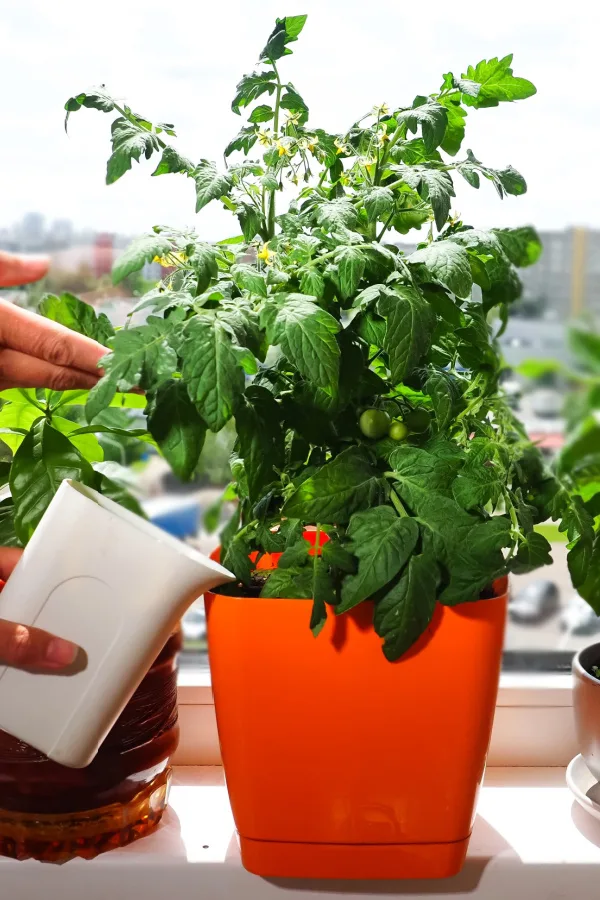
As for feeding, tomato plants are notoriously heavy feeders. Since potted plants only have a limited amount of soil and resources, it is even more important to feed them consistently.
Use half a dose of all-purpose commercial liquid fertilizer every two weeks for indoor tomatoes. Alternatively, you can use compost tea or worm castings for a great, organic slow-release fertilizer. When using either of these teas, apply weekly. (Affiliate Product Link: Espoma Organic Tomato Fertilizer)
Additional Tips To Grow Tomatoes Indoors
As with any indoor plant, keep your tomato plants away from any drafts or areas with abrupt temperature changes. If you run a furnace in the winter and the air is extremely dry, add a humidifier.
On the flip side, if you live in a very humid environment, a fan or dehumidifier will help to prevent mold or other issues from occurring from the buildup of moisture. You do not need to prune determinate tomatoes that you grow indoors. You can prune suckers if you wish to keep the plant at a certain size, but it is not required.
Lastly, be sure to harvest your tomato plant often. The more you harvest, the faster it can work to ripen the rest of the crop. Here’s to enjoying fresh, juicy, ripe tomatoes grown right in your own home – no matter the growing season!
Follow Our Facebook Page For Even More Great Tips! Simple Garden Life Facebook Page
Simple Garden Life is a website dedicated to keeping gardening fun, simple and enjoyable! We publish two new articles each week along with a new garden podcast episode every two weeks. This article may contain affiliate links.
